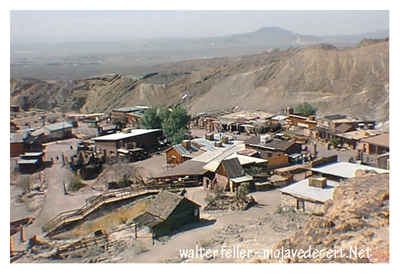Pittman Silver Act
In April, 1918 Congress passed the Pittman Silver Act. Under provisions of this law the United States purchased about $260 million dollars worth of silver at $1.00 an ounce. This silver was used to coin silver dollars. As a result there was renewed mining at Calico, but most importantly, the well timed discovery of the Kelley-Rand silver mine in 1919 soon became the largest silver producer in the state. This deposit was discovered right beside the road that is now U.S. Highway 395 in an area that had been intensely prospected since 1895.By the end of World War I the frontier was gone. Accurate maps had existed for decades. Roads and railroads crisscrossed the desert. The Automobile Club of Southern California placed road signs through out the desert. Soon dirt roads would be replaced by pavement. Truck transportation would replace rail for many operations. Electrical lines already served the largest operations. High- volume low-grade operations were replacing the high- grade deposits that led to the discoveries in the first place. During the 1920s, inflation and the fixed price of gold put a damper on mining. Increasingly industrial minerals would play a more important role in the mining mix. During the 1930s the price of copper bottomed out, however the increase of the fixed price of gold in 1933 stimulated gold mining for a while. But by government order gold mining was shut down during World War II in order to concentrate on the mining of strategic minerals such as iron, tungsten, copper, and lead. After the war, gold mining did not recover. Again, inflation and fixed gold prices were the primary reason. In 1968 the price of gold was no longer fixed. The high price of gold coupled with new innovations in the fields of exploration, mining, and recovery led to a new gold rush through the western United States. During the last few decades, large low-grade gold deposits have been mined in California. But it is the huge deposits of salines, borax, gypsum, and limestone that will continue to be mined for many dozens of decades yet in the future, providing the nation and the world some of the basics of every-day life.
Previous - Next
Bibliography

Calico, California